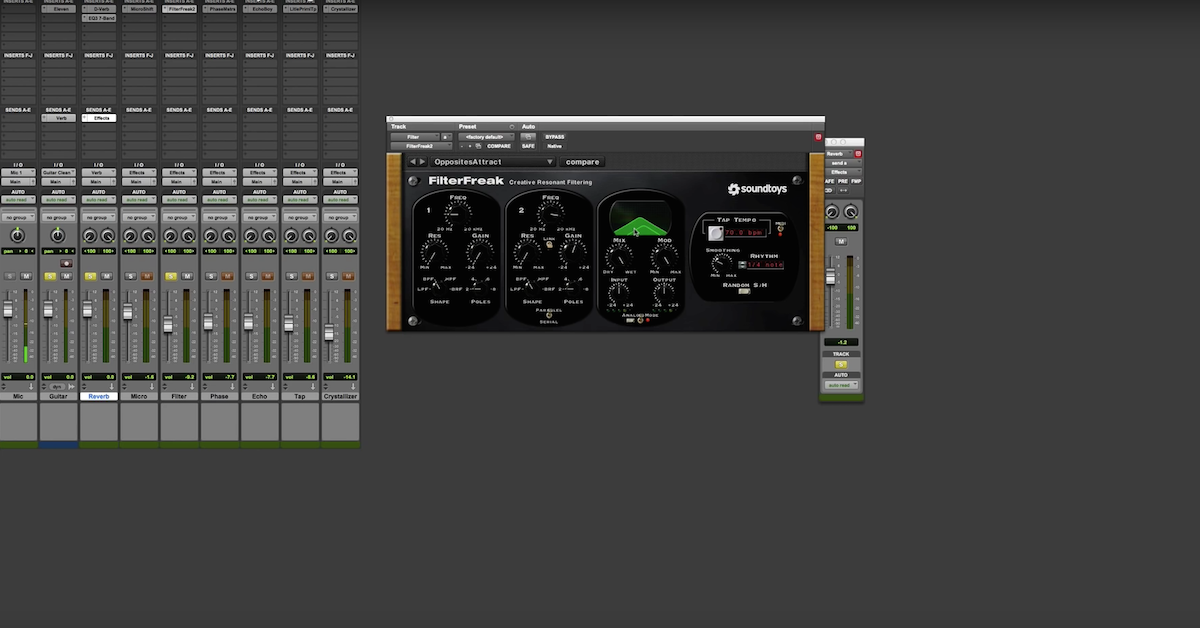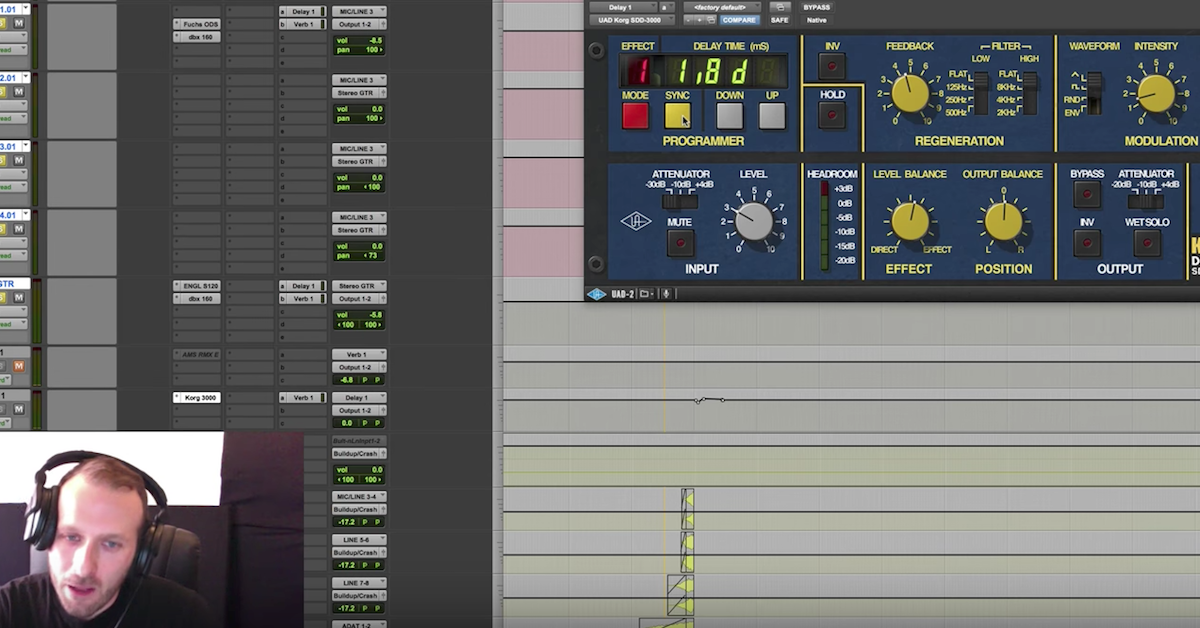How to Create a Unique Auto Pan Effect on Electric Guitar
So what’s the idea with this effect? Typically, what we’re going to do is introduce some processing, so our signal sounds as if it’s moving left to right across the stereo field.
I’m going to show you how you can implement that, and then we’re going to take it a step further. We’re going to think about what we can do to get this signal to also move from front to back.
So we’ll put these two things together, and then it’s as if our signal is spinning. So we’ve got two dimensions – side to side, and then also front to back.
So here’s what we’re working with. This is just a rhythm guitar part, electric guitar part, one that might be used with an auto-pan style effect. So I’ve got it synchronized here with the tempo of my track. I’ll let you listen to it, so you can hear the way that I’ve got it setup on the grid.
[guitar and click]
So, some really nice, open, long sustaining notes. Something that will work well with this style of effect.
So I’ve got it setup with the grid of my track which is going to be important, because we’re going to do this manually. We’re going to create this auto-pan style of effect.
So first off, what we’re going to do is we’re going to change the pan. The pan is going to help us move this signal from left to right. So I’ll go in there to my automation and select pan.
So now I’ve got this line, and I can move it to wherever we want. I could, you know, start it over here on the left side, listen to it now.
[guitar, panned left]
Right. You get the idea.
I’ve set it up so that my grid is now on each bar, and then I’ve selected the mode to also be grid. This way, when I click, it will only latch on to those particular points.
So what I’m going to do to begin with is have a nice, slow, auto-pan style of effect, where I’m going to go back and forth from each side. It starts over here on the left, moves back and forth from left into right, all the way to the end.
I’ve set it up that this is actually going to be every two bars. Every four – eight beats total for the cycle. So I’ll end it over here. Let’s listen to what we’ve introduced now. You should hear it moving from left over to right.
[guitar, auto-panning]
So hopefully you’re able to hear that.
What have we introduced now? Some processing, a way of panning the signal so that it’s automatically going to shift from the left side to the right side. So we’ve got it moving in that one dimension.
Let’s also think about what we can do to make it seem like it’s getting closer to the listener, and also further away. Introduce a second dimension.
I’m going to do this – My idea is to use reverb. So I’m going to create a reverb plug-in here, insert one. This can be any one you’ve got, as long as we can work with the wet/dry balance.
So I’m going to pull up here just a stock D-verb plug-in, and let’s set it up with a basic kind of hall. Maybe a medium hall. About, I don’t know, one second or a little bit less than that. That should be good.
Introduce even some pre-delay. I think that should work well. Let’s bring up the gain here so that it’s at about unity gain, and then let me back this off. Get a decent sound by itself. Let’s listen to this.
This is just the straight reverb being added to the signal.
[guitar reverb]
Hopefully, to you, it sounds as if it’s further away. Right? Alright, I’ll bypass it. Think about it being close, and then that’s when the reverb is off, and then fully wet, further away.
[guitar, reverb off and on, with panning]
Alright, so what I’m going to do now is automate the wet/dry balance, in a similar way that I did with the panning. This way, it’s going to go from being dry, which means it’s going to sound as if it’s close with not a lot of those repetitions or reflections, to being wet. That’s when we’ve got a lot of those reflections.
So enable automation on this one here. Then I can bring it up on my time line. What I’m going to suggest is actually open up here using this triangle, open up a second one. We’re going to switch on the rhythm guitar wet/dry.
The purpose for this is what I want to do – my idea here is so that it’s kind of the opposite of what we have for the left and the right. So the idea is here, it’s in the center. When we’re in the center here, why don’t we have that be 100% wet? And then we’ll go over to the right side, come back to the center again, and then, we’ll have that one be also in the center. So this one I need to bring down to about 50% here.
So on the sides, think of it as a circle. If it’s a circle, then when we’re in the center, we’re far away. Then, we go to the sides, and when it’s coming around closer, and then when we get to the center again, that’s when we come all the way up close to the listener, and then we start to move further away, and as we go through these cycles, now we can create the perception of this thing spinning around in a circle. Kind of like a rotary style effect.
So here we’ve got it now with our – it’s just slightly offset, these cycles occurring, so we can get that spinning sort of thing. This is something you can experiment with yourself, what you think sounds best. Whether it’s this alignment of these things, or something else.
But listen to it now. We are introducing some things so that we have another dimension.
[guitar, panning and reverb automation]
So the way that I’ve done it, I’ve created a very slow effect. This might even work better if you sped it up and did it double time. The main thing was just to give you a simple illustration to kind of wrap your head around, but experiment with this. Try it out on your own.
If it’s faster – you know, the idea is can we trick the listener in to kind of perceiving all of these different variations of the sound going on.
So that’s it. Creative, unique sounding auto-pan effect. Take care, guys.





